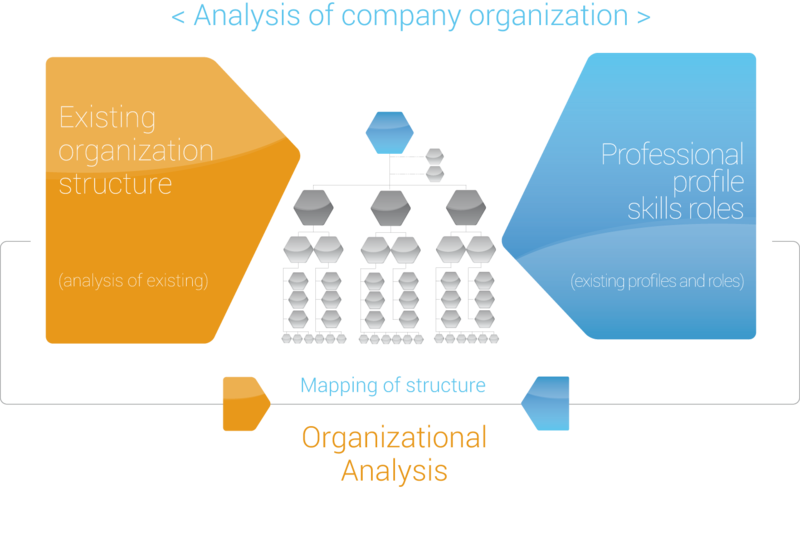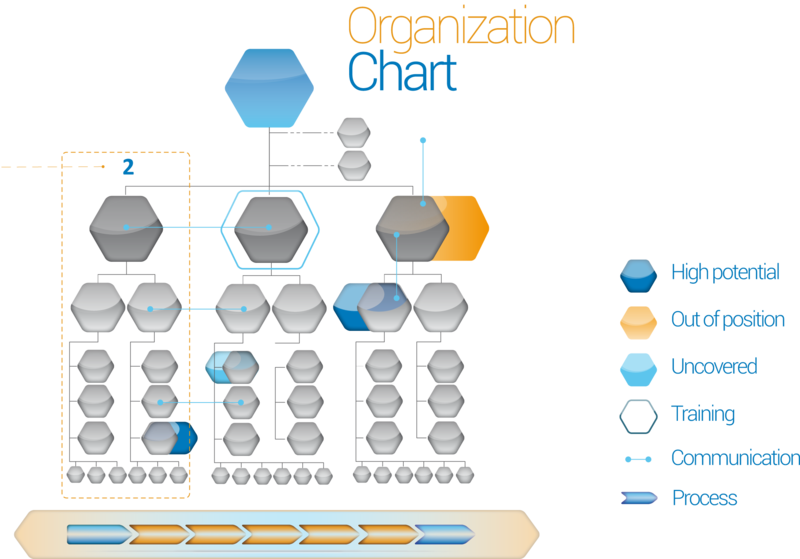‹ HR Consulting
WHAT WE HAVE
This takes us to the second step in consulting. Once the organizational plan has been analysed, an assessment can be made of the existing organizational structure.
- Defining the organizational analysis plan
- Defining analysis tools
- Reporting organizational status
- Reporting organizational behaviour
- Reporting organizational skills and styles
- Reporting a plan of intervention
The output of the project gives a vision of which structure is available and an understanding of whether it is in line with goals or whether corrective measures are required.
‹ HR Consulting
What We Have
The proposed Analysis Service places the focus on the people comprising the organization. The business analysis method provides seamless interventions regarding the people and aspects involved in relation to production capacity, finance, layout, market conditions, scenarios, etc.
Organizational change is almost impossible if it is not based on collective levels of intervention, i.e. on all the people who comprise the company, and even more so on external interventions and factors influencing existing aspects. The first step towards organizational change is to assess the Company and have a good knowledge of it.

The method employed is based on interviews, tests, assessments and questionnaires, with specific procedures adapted to the type of Client and to organizational segmentation. The feedback model will be initially prepared by the Consultant, with questions aimed at analysing the atmosphere. Following the interviews, a comprehensive document will be drawn up that gives an overview of the company.
Approach to analysis
The approach will involve sharing and social dialogue (not only external intervention), with the highest level of sharing with the company's owners and management. This will be followed by assisting with disclosure to all the people involved by means of general and individual meetings. The first people who need to gain knowledge of the organization are those who are part of the organization itself. This process will make everyone aware of what the organization is and what it produces. To be successful, organizational wellbeing is required.
The organization and the company need to be perceived as two related entities with invisible systems of interconnected actions. "Systems thinking is the discipline of seeing wholes." (Senge, 1990) It aims to analyse relations instead of separate things. Each person (none excluded) is considered an integral part of the system, which is difficult to see when attention focuses on the immediate present (and not on the future). Attention to isolated parts of the system will be avoided in order to solve issues in the short term.
Using pre-defined tools (tests, questionnaires and interviews), an in-depth analysis will be made of individuals operating within the business organization.
The output of the process allows human resources to be profiled in terms of: skills, behaviours, aptitudes, strengths and weaknesses, areas of development, etc.
The results obtained and an individual interview are used to compile a complete confidential dossier. The last step analyses how far the profile is aligned with the company's organizational and development plan.
Such analysis is instrumental to the recovery of eventual gaps detected, by means of training, development, horizontal or vertical shifting of staff, etc.
The same type of analysis can be extended to a group or team (functional, divisional, organizational, business, etc.), analysing the dynamics, communication, relations and internal balance.
The process provides a complete picture of the team as follows: welcoming new staff, transferring skills, pursuing business objectives, a sense of belonging, internal sub-hierarchies, a positive atmosphere, etc.
The work method adopted by the Link HR consultant will be one of individual and group interviews in order to compile detailed charts (prepared at the start of the project). At the end of the process, the charts will be consolidated in a full business report.
1. Organizational unit
Each individual organizational unit (or Person) is segmented according to the following: length of service, category, type of contract, salary, cultural level, nationality, etc., which are all used to perform the analysis.

2. Functional area
Each functional area (purchases, production, logistics, administration, sales, etc.) will be mapped according to the activities performed and to the number of units it has, as the total number of people interviewed and referred to the managed process (or one of its stages).
3. Organizational level
The Consultant will meet each person, separating the meetings and related implementation timing according to the organizational level as follows: workers, office staff, professionals, heads of department, project managers, managers, executive managers, etc. Each interview will be carried out with different timing and methods.
ANALYSING ORGANIZATIONAL POSITION
Each person will be assessed according to the job position held, the activities performed and to his/her suitability for that position. The overestimation or underestimation of each role will be assessed in relation to the person and/or potential for development.
ANALYSING ORGANIZATIONAL FUNCTIONS
Grouping people into a functional area will be useful to understanding its composition, effectiveness and efficiency. An assessment will be made to see whether the function is aligned with the business growth and development strategy, and whether it represents an opportunity or a bottleneck to the business process.
ANALYSING INTERNAL RELATIONS
The output of the interviews will provide a clear overview of internal relations between company owners and managers, between managers, between managers and workers, and workers and managers, etc.
ANALYSING COMMUNICATION (Communication Model)
The interviews will be helpful in assessing communication flows within the company, using organizational levels and intermediaries (Managers) in order to understand the message arriving from company owners to workers and that returning to the owners from the workers. An assessment will be made to see if the message is coherent or whether distortions exist.
ANALYSING THE ORGANIZATIONAL ATMOSPHERE
Understanding the organizational environment as a whole to get an overview of relations and communication. Understanding which activities influence the company atmosphere, which players control it and which actions are helpful to its improvement.
ANALYSING MOTIVATION (Motivational capital)
Motivation is undoubtedly the driving force behind any organizational action. Achieving goals, maintaining strong organizational commitment, supporting and facing change, and having the right level of concentration are all fundamental aspects of a company’s success. With such an analysis, we can define the company's motivational profile and contribute to the development of its motivational capital. In a period of economic downturn, it is essential to monitor the motivation and perception of staff.
ANALYSING SKILLS (Skills Model)
A fundamental aspect of the skills model is the link between these and their field of application in terms of role, function, company and strategy. Each skill is linked to behavioural indicators, namely, the specific behaviour of people who possess a certain skill. The model is used to identify the personal knowledge, skills, expertise and aptitudes required for the effective performance of a person in a specific role.
ANALYSING STRATEGIC ALIGNMENT
An overview of the previous points is the basis for making an assessment of the appropriateness of organization for the company's growth and development plans and identifying the corrective actions to put in place (replacements, new placements, training, shifting of staff).
The analysis work ends with creating an organizational profile, provided with individual points of intervention on the structure. This will provide an overview in relation to the specific process applied throughout the company.
Organization Chart
On concluding the analysis, the company, with the aid of a Consultant, will devise a plan of intervention in order to act on its organization in a complete and coordinated manner. The overview of the company is evaluated in relation to the business strategy to lay the foundation for specific intervention with regard to People. Recruitments, new placements, shifting staff and training will be the subject of actions for organizational alignment.
Organization Plan
The map of the organization highlights the critical issues and helps to define the timing, type and mode of intervention with regard to individual people and groups. The organizational analysis process ends with defining the services and tools for direct intervention on organization.
